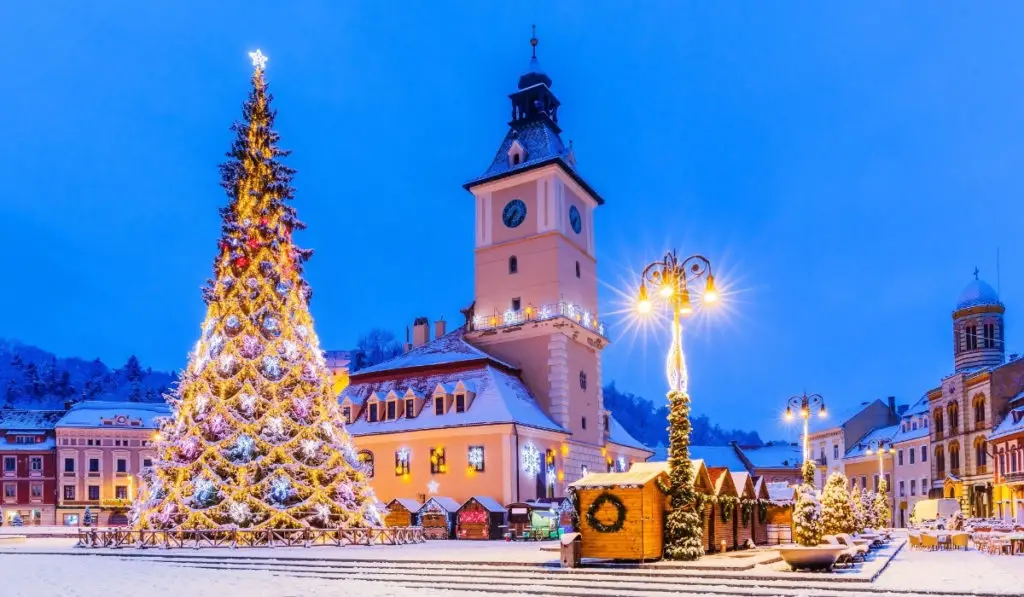This post may contain affiliate links. At no cost to you, purchases made through these links may result in a small commission for Traveling Transylvania. We never recommend products that we don’t know and trust. Thank you for your continued support!
Hello from Transylvania! In the three years I’ve settled amidst the hauntingly beautiful landscapes of this region, transitioning from the colorful streets of Sibiu, to the medieval charm of Sighișoara, and back to the bustling vibe of Cluj-Napoca, I’ve experienced a whirlwind of culture, traditions, and yes, culinary adventures! (Sarmale, I’m looking at you.)
But let’s chat about something truly magical: Christmas in Romania. While I grew up with the familiar American traditions of Santa Claus and eggnog, the Romanian festive season has been a delightful revelation. The warmth, the Romanian Christmas traditions, and the sheer passion with which locals celebrate made me feel right at home.
It’s like discovering an age-old storybook filled with tales of snowy landscapes, vibrant markets, melodious carols, and traditions that have stood the test of time. Each page introduces you to a festivity that is rich in symbolism, spirited in celebration, and absolutely delicious in flavor.
Getting the hang of “Crăciun Fericit” (Merry Christmas in Romanian) took a minute! But, embracing and understanding the essence of a Romanian Christmas? That, my friends, has been an unforgettable journey. Join me as we embark on a festive exploration of the unique, heartwarming, and sometimes amusing Christmas traditions that Romania, my beloved adopted homeland, holds dear.
- The Basics of Christmas in Romania
- Romanian Christmas Traditions – How Does Romania Celebrate Christmas?
- Saint Nick – Moș Niculae
- Christmas Fasting (Postul Crăciunului)
- The Pig Slaughtering (Tăierea porcului)
- Decorating the Christmas Tree
- Christmas Eve (Noaptea de Ajun)
- The Caroling (Colindatul)
- The Star Carol (Steaua)
- The “Goat” Tradition (Capra)
- Christmas Markets
- Sibiu – The Crown Jewel
- Bucharest – The Capital’s Festive Showcase
- Cluj-Napoca – A Blend of Tradition and Modernity
- Craiova – Oltenia's Festive Heartbeat
- Market Highlights
- Popular Romanian Christmas Cuisine
- Unwrapping the Magic of a Romanian Christmas
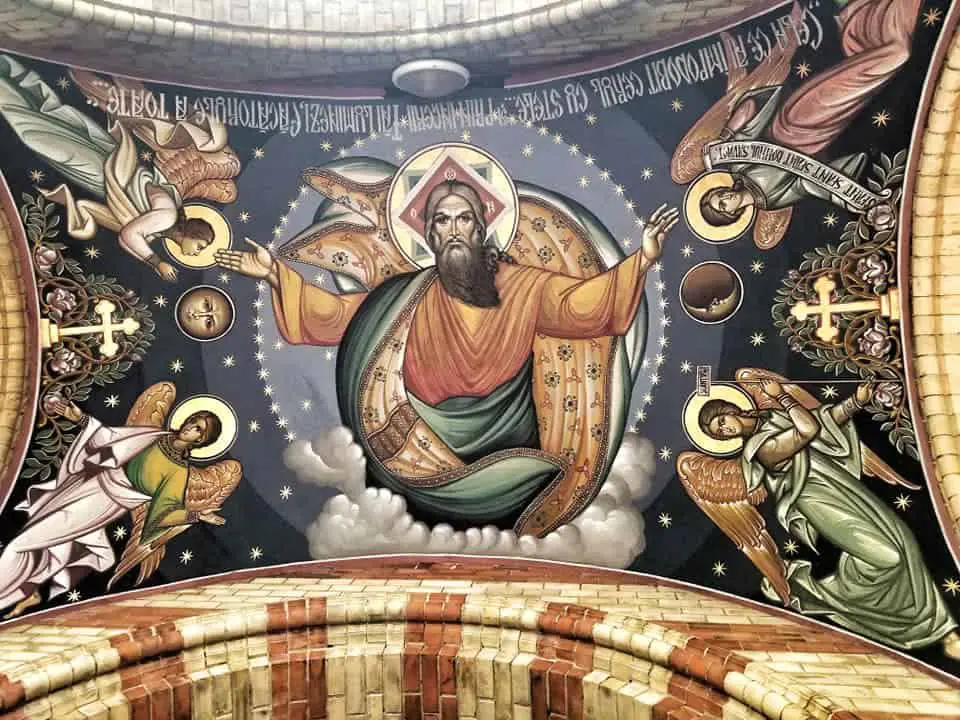
The Basics of Christmas in Romania
Diving deep into Romanian Christmas traditions, one cannot sidestep the notable influence of the Eastern Orthodox Church on the celebrations. Even in the midst of Transylvania’s majestic landscapes and Gothic tales, the spiritual essence of a Romanian Orthodox Christmas shines brightly.
Eastern Orthodoxy and its Christmas Imprint
At the heart of a Romanian Christmas is the Eastern Orthodox faith. This not only dictates the religious undertones but also shapes the cultural festivities. With over 80% of the Romanian population identifying as Orthodox Christians, it’s no wonder that this religious thread weaves a rich tapestry of traditions.
When Does Romania Celebrate Christmas?
The Advent season, known locally as Postul Crăciunului, marks the beginning. Spanning from November 14th to December 24th, it’s a significant 40-day fasting period leading up to Christmas on December 25th. Far from the simple chocolate-filled advent calendars I was accustomed to, this period in Romania is steeped in spirituality. Devout Orthodox believers must embrace a simpler diet to prepare spiritually for Christ’s birth.
St. Nicholas Day & the Birth of Christ
The festive fervor truly sets in on Ziua Sfântului Nicolae or St. Nicholas Day on December 6th. However, the height of the celebration is on December 25th and 26th, when the birth of Christ is commemorated with religious zeal and festive joy.
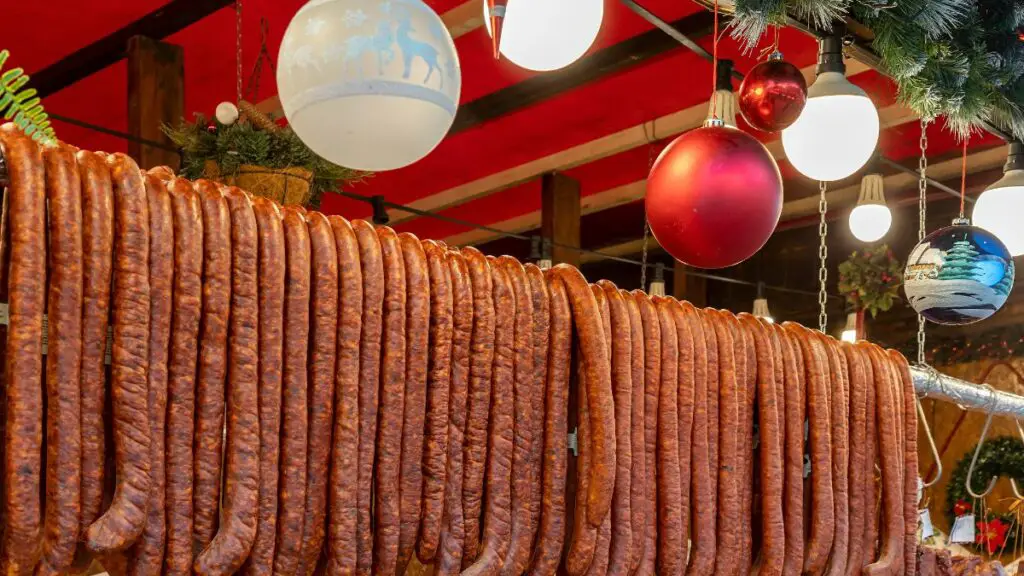
Romanian Christmas Traditions – How Does Romania Celebrate Christmas?
Saint Nick – Moș Niculae
Ah, Moș Niculae! Now, here’s a day that instantly warmed my heart. Of course reminding me a little of the Santa Claus fervor back home, but with its own distinct Romanian twist.
In Romania, St. Nicholas (Moș Niculae)is not just the jolly old fellow who slides down chimneys. Rooted in Eastern Orthodox tradition, he’s revered as a saint, a protector of children, and sailors too. While St. Nick legends abound worldwide, in Romania, he’s celebrated as a mix of a benevolent bishop who secretly gives out gifts and a figure of faith who’s deeply embedded in Orthodox Christian lore.
Romanians celebrate their version of ‘Santa’ almost 20 days before we do! On December 6th, children eagerly clean their boots and place them by the window or door, hoping to find them filled with treats the next morning. Those who’ve been good receive fruits, nuts, and sweets, while the mischievous ones might find a twig or two. It’s an adorable blend of fun, lessons, and Romanian Christmas traditions!
The day is marked with the joy of giving and receiving. It’s also a time of attending church services, singing hymns, and remembering the saint’s deeds and miracles. It’s the perfect mix of spirituality and festivity, capturing the essence of an Orthodox Christmas in Romania.
Steeped in history and blended with local traditions, Moș Niculae stands as a testament to Romania’s rich cultural tapestry. And trust me, experiencing it firsthand is nothing short of enchanting!
Christmas Fasting (Postul Crăciunului)
If you’re picturing a pre-Christmas scene filled with indulgent feasts and over-the-top dinners, you might want to hold onto that thought when in Romania. Why? Enter Postul Crăciunului – the Christmas Fasting.
The Eastern Orthodox Church plays a significant role in shaping the festive spirit in Romania. One of the most profound expressions of this faith leading up to Christmas is the Advent fast, locally known as Postul Crăciunului. Beginning on November 14th and stretching till December 24th, this 40-day period is not just about giving up certain foods. It’s an exercise in self-discipline, spiritual growth, and anticipation for Christ’s birth.
When I first learned about it, I couldn’t help but wonder: “In a society that relies so much on meat, how do they manage?!” Romanians abstain from meat, dairy, eggs, and other animal products during this period, embracing a predominantly vegan diet. But this isn’t a somber time. Instead, it’s marked by creativity in the kitchen, where traditional dishes are tweaked to fit the fasting guidelines, and let me tell you, some are absolutely delicious!
Beyond the food, Postul Crăciunului represents a time of introspection, prayer, and spiritual preparation. It’s a beautiful juxtaposition – as winter sets in and the days grow shorter, the inner light of faith shines brighter in many Romanians, as they prepare to welcome the Savior.
To witness and somewhat partake in this tradition has added depth to my understanding of Romanian culture, blending faith, tradition, and, believe it or not, some delicious culinary delights! As you can imagine, it’s a great time for vegetarians visiting Romania!
The Pig Slaughtering (Tăierea porcului)
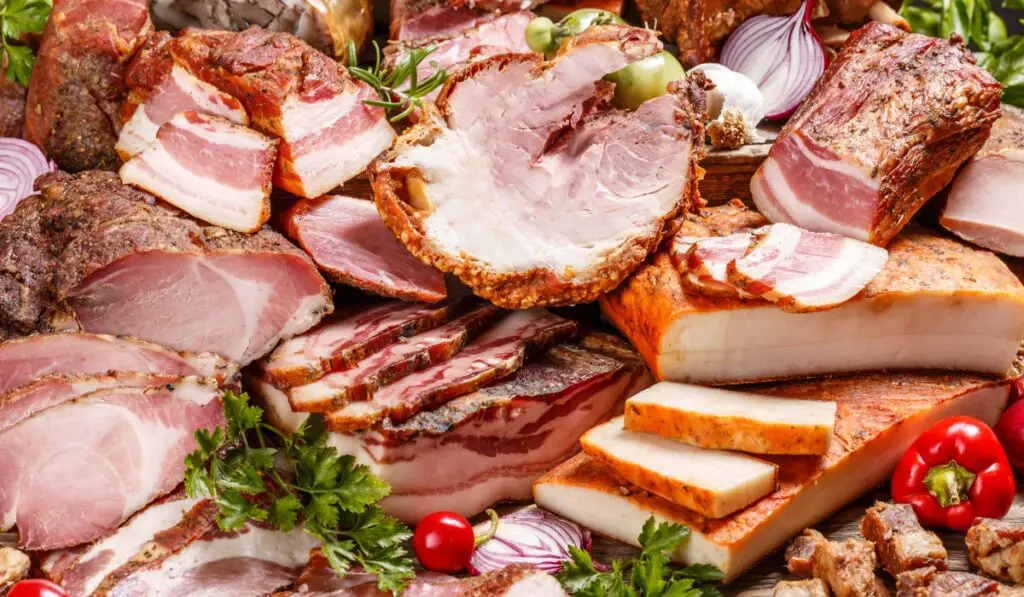
Tăierea porcului is a deeply rooted Romanian Christmas tradition that signifies abundance, preparation, and the communal spirit of the festive season.
The tradition of pig slaughtering in Romania predates Christianity. This ritual was initially associated with the winter solstice, a way to ensure food supply during the cold winter months. Over time, as Christianity took hold, the practice intertwined with Christmas preparations.
Usually occurring a while before Christmas, families come together for this age-old custom. The pig, which has often been raised by the family or neighbors throughout the year, is humanely slaughtered, and every part of it is used to prepare a plethora of dishes. Nothing goes to waste.
I must admit, I’ve never been there for it. As a former vegetarian, and an aversion to meat as it is, I don’t think I could handle it. But understanding its deeper meaning and the gratitude expressed towards the pig for providing sustenance makes it a poignant ritual rather than just a practical act.
While it ensures a table filled with dishes like sarmale (cabbage rolls) and cârnați (sausages), Tăierea porcului also symbolizes family togetherness, gratitude, and the continuity of traditions. It’s about honoring the past, celebrating the present, and ushering in a future filled with hope and abundance.
Being amidst this celebration, one realizes the profound connection Romanians have with their land, traditions, and each other.
Decorating the Christmas Tree
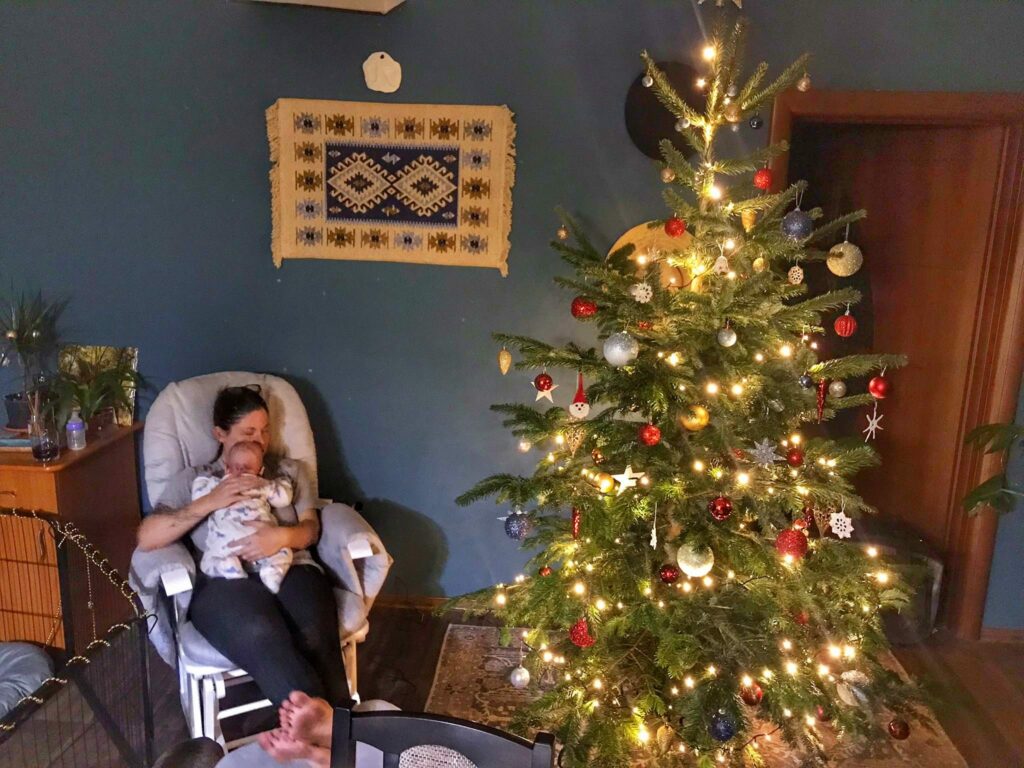
Just when I thought my Christmas tree decorating game was strong, Romania threw me a delightful curveball. In the land of vampire tales and picturesque castles, the act of adorning a Christmas tree, or brad de Crăciun, isn’t just about glittery ornaments and twinkling lights. It’s a heartfelt tradition imbued with nostalgia, symbolism, and a dash of Romanian flair.
In many Romanian households, the Christmas tree is truly the heart of the celebrations. Just like back in the States, families here eagerly anticipate the act of picking out the perfect tree. But unlike the towering firs I was used to, many Romanians prefer their trees a bit more modest in size (or artificial), yet every bit as grand in spirit.
While tinsel, stars, and shimmering ornaments are commonplace, what captivated me were the unique additions of Romanian Christmas decorations: handcrafted straw ornaments, wooden carvings, and even intricately painted eggs. My mother-in-law makes these gorgeous knitted snowflakes and bulb ornaments with the help of a balloon.
Gathering around the tree, families share memories of Christmas past, sing traditional Romanian Christmas carols, and revel in the warmth of togetherness. It’s not just about making the tree look pretty; it’s a ritual that binds families, celebrates heritage, and welcomes the festive season.
Experiencing the Romanian way of tree decorating was like unwrapping a gift filled with history, love, and a sprinkle of magic. And I must say, my brad de Crăciun decorating skills have since leveled up!
Christmas Eve (Noaptea de Ajun)
Ah, Christmas Eve! Or as they say here, Noaptea de Ajun. This isn’t just any other night; it’s a magical prelude to the grand Romanian Christmas traditions. From eerie tales to heartwarming traditions, this evening blends the mystical with the devout, creating a tapestry of emotions and memories.
One of the first things I learned is that Noaptea de Ajun isn’t just about the anticipation of Christ’s birth. Romanian folklore believes this is the night when the veil between our world and the otherworldly becomes the thinnest. Spirits walk amongst the living, and animals are rumored to speak in human tongues! It’s like Halloween got a festive makeover.
As the sun sets, families gather wheat sheaves, symbolizing the richness of the past year and hopes for abundance in the next. These sheaves, called “cucii“, are decorated and placed around the house, lending a rustic charm and deep significance to the celebrations.
Even though it’s a fasting day, Romanians have a knack for turning restrictions into gourmet delights. The dinner on Christmas Eve is usually entirely vegan. Yet, the table groans under the weight of delicious dishes: bean soups, stuffed peppers, veg-friendly sarmale, pickled vegetables, and of course, the much-loved cozonac, a sweet bread bursting with cocoa and walnuts.
Being a part of Noaptea de Ajun in Romania, one is enveloped in a world where the past, present, and the ethereal dance together, heralding the joyous day to come.
The Caroling (Colindatul)
One of the Romanian Christmas traditions that absolutely captivated me during my holidays here, is Colindatul – the beautiful practice of caroling. And let me tell you, it’s not your average door-to-door jingle session. Oh no, this is an age-old custom that combines melodious tunes, vibrant performances, and a sprinkle of Romanian charm.
Caroling in Romania is more than just singing; it’s a theatrical experience. Groups, often comprising young men, don their best costumes (some traditional, some downright whimsical), a bottle of tuica, and traverse neighborhoods and apartment blocs, serenading locals with songs that span themes from the nativity to Romanian legends and daily life.
Imagine my surprise when, on my first Noaptea de Ajun here, there was a knock on my door, and I was greeted not just by harmonious voices but by carolers brandishing bells, sticks, and even some dressed as bears or goats! It’s a lively, heartwarming spectacle that infuses the frosty air with warmth and jubilation.
It’s customary to reward these merry troubadours. While it used to be traditional foods, nuts, or fruits, today, it’s often money or sweets. But more than the tangible rewards, it’s the smiles, the blessings, and the shared joy that truly matter.
As the nights in Romania grow colder, the heartwarming melodies of Colindatul serve as a beautiful reminder of community, tradition, and the shared spirit of the festive season. If there’s a way to usher in Christmas with a bang (and a song), Romania sure knows how!
The Star Carol (Steaua)
Navigating the winter nights of Romania, you’ll often witness a spectacle that’s both vibrant and spiritually evocative – the procession of Steaua, or the Star Carol. To say it’s mesmerizing would be an understatement; it’s like stepping into a living tableau of faith, folklore, and festivity.
At the heart of this tradition is a large star, crafted from colorful paper and often adorned with Christian icons or scenes from the Nativity. Attached to a pole, this star is carried from house to house, its shimmering presence illuminated by candles or, nowadays, battery-operated lights.
Accompanying this moving star are carolers singing Steaua, a song that tells the story of the Star of Bethlehem and its role in guiding the Three Wise Men to the birthplace of Christ. Their voices, harmonizing in the chilly air, transform the urban streets and rural pathways into corridors of echoing tales and prophecies.
For Romanians, Steaua is not just about the star or the song. It symbolizes guidance, hope, and the ever-present light of Christ. The act of moving from home to home, sharing the story, underscores the importance of community and shared faith.
The “Goat” Tradition (Capra)
Just when I thought I had a handle on Romanian Christmas traditions, along came Capra, the Goat Custom. If you’re picturing serene pastoral scenes with actual goats grazing, think again! Capra is a quirky, colorful, and somewhat raucous celebration that adds a dash of humor and a good dose of cultural richness to the festive season.
Capra primarily involves a dance performance where one participant dons a goat costume, complete with a mask and often jingling bells. Accompanied by music, the “goat” prances, leaps, and dances, sometimes even engaging in playful antics, much to the amusement of onlookers.
While it’s easy to get lost in the fun and frolic, Capra has deeper roots. The goat is seen as a symbol of strength and fertility. Historically, this dance was believed to chase away evil spirits and ensure a prosperous New Year. Today, while the deep-rooted beliefs might have faded slightly, the joy and vibrancy of the tradition remain intact.
Christmas Markets
Christmas in Romania is akin to a festive wonderland, and the country’s iconic Christmas markets are a testament to that magic. A delightful blend of tradition, gastronomy, and crafts, these markets are not just shopping destinations but cultural experiences.
Sibiu – The Crown Jewel
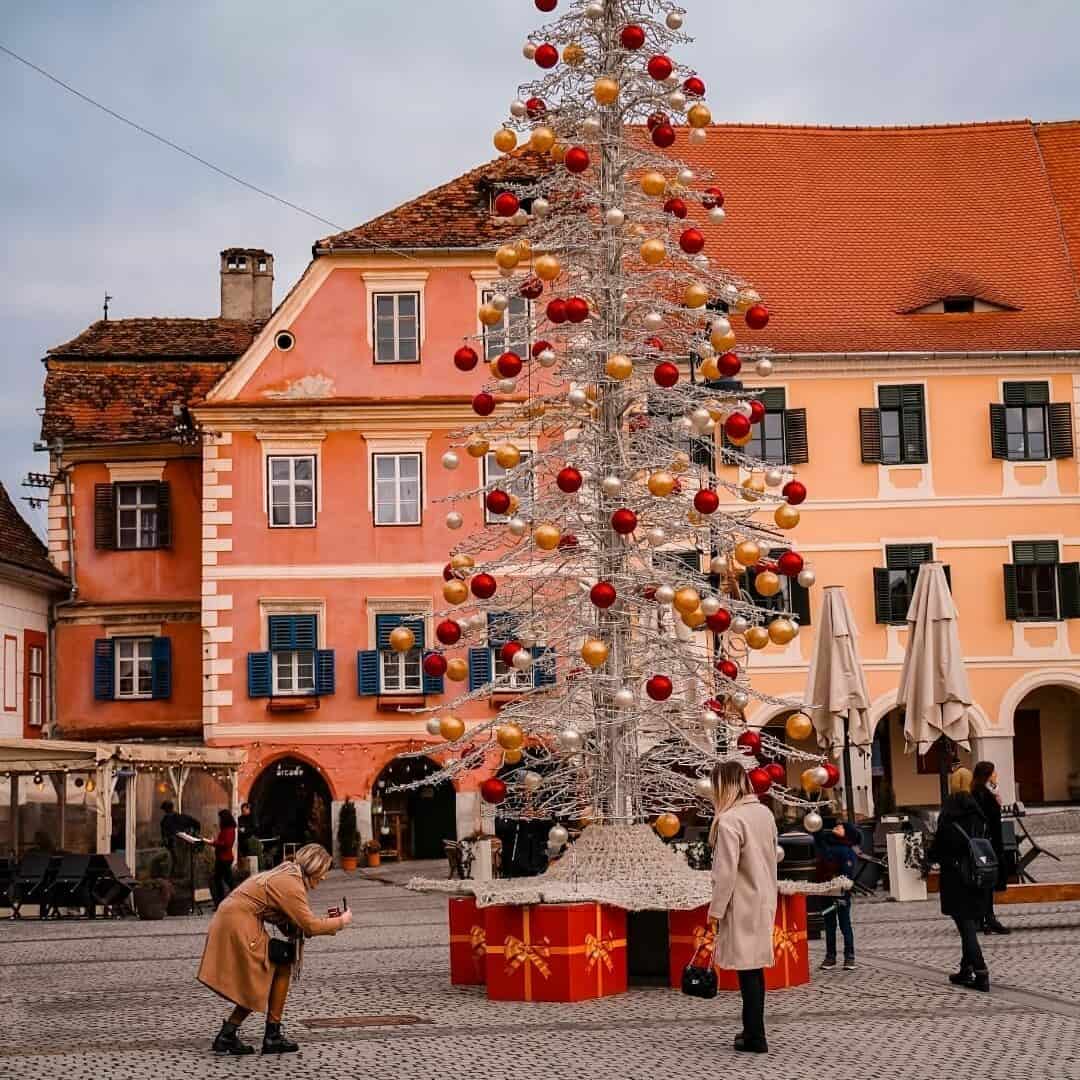

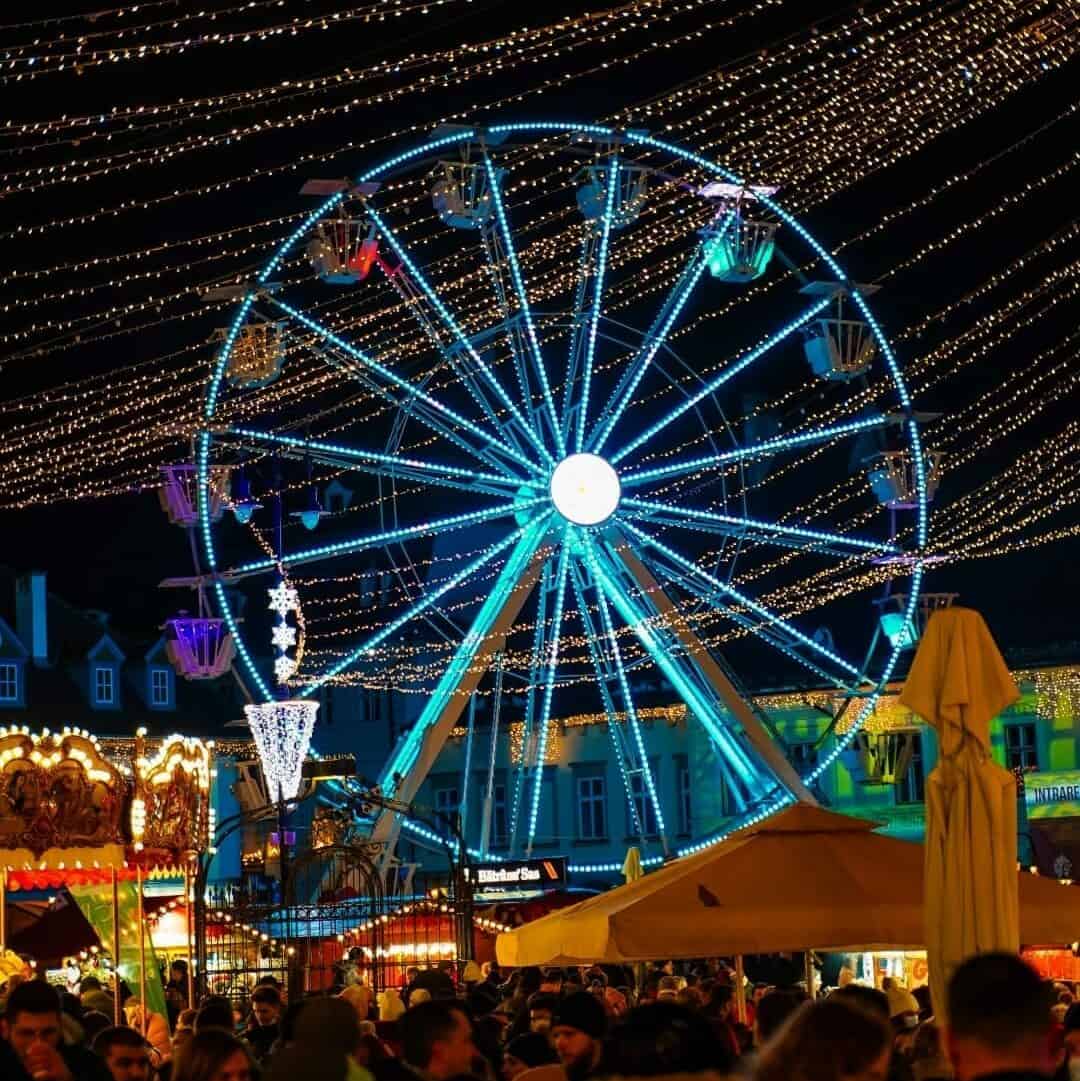
Nestled in Sibiu’s Grand Square (Piața Mare), this market is often heralded as the most beautiful in Romania. With baroque buildings providing a colorful backdrop and the city’s iconic Council Tower standing guard, the market stalls shimmer under fairy lights, offering an array of traditional crafts and delectable treats. Dominating the scene is a resplendent Christmas tree, awash with thousands of lights, as well as an ice rink set up in Piata Mare for attendees of all ages to enjoy.
Bucharest – The Capital’s Festive Showcase
Bucharest’s Constitution Square comes alive with festive spirit, boasting an expansive ice park, a grandiose Christmas tree, and numerous stalls that brim with holiday offerings.
Cluj-Napoca – A Blend of Tradition and Modernity
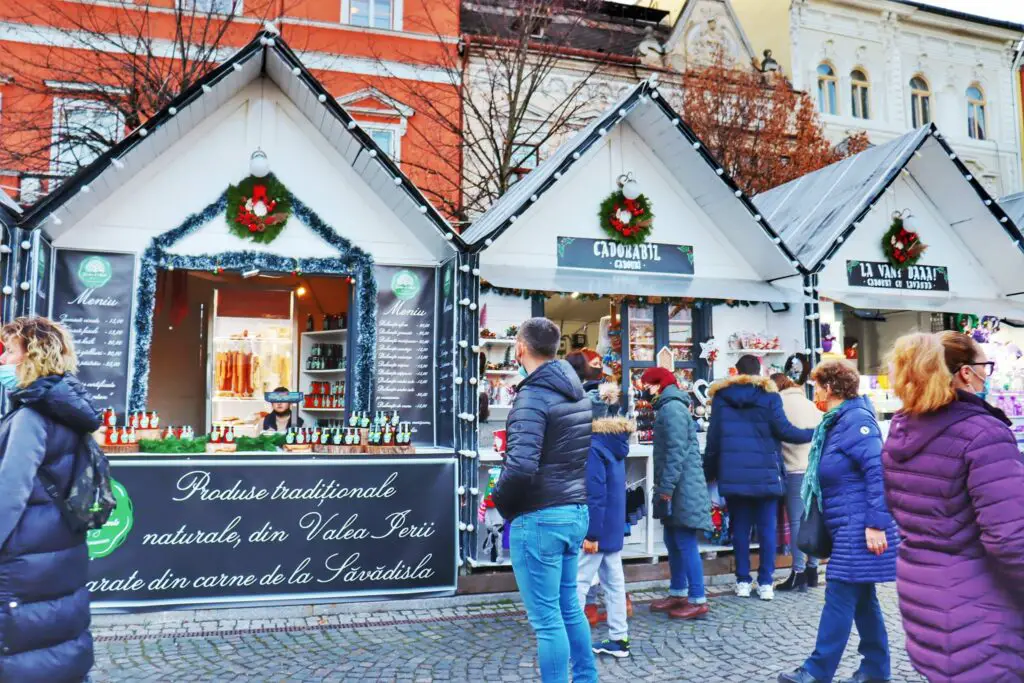
The market in Cluj-Napoca’s Union Square (Piața Unirii) offers a delightful mix of the old and the new. Traditional stalls stand alongside contemporary setups, offering everything from time-honored crafts to modern trinkets. Visitors can indulge in live music and even take a spin on the ice skating rink.
Craiova – Oltenia’s Festive Heartbeat
A mention of Romanian Christmas markets would be incomplete without the vibrant market of Craiova. As one of the prominent cities of the Oltenia region, Craiova’s Christmas market beautifully mirrors the region’s rich culture. The market, set against the backdrop of elegant administrative buildings and the city’s fountains, is a burst of colors and sounds. Here, one can find unique crafts characteristic of Oltenia, alongside the universal favorites.
Market Highlights
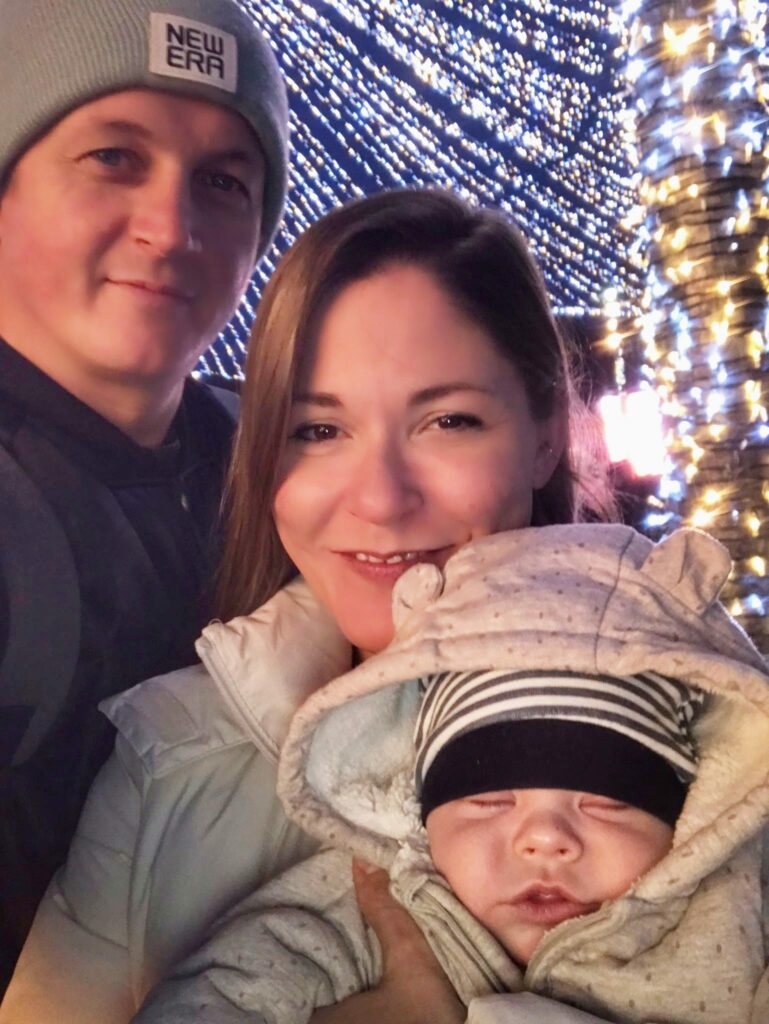
Starting in late November and often extending past Christmas, these markets offer a treasure trove of gifts available. There is a mix of cheap, mass-produced items with artisanal handicrafts. My biggest disappointment in the markets here is that there are so many cheap items.
However, the gastronomic delights, such as mulled wine, sweet chimney cakes (kürtőskalács), and grilled sausages, are something to write home about, tempting visitors with their delightful aromas. I always make sure to pick up a jar (or three) of dulceata de ardei iute (hot pepper jam), and Szilard usually gets some sausages or slanina.
The holiday markets are a wonderful staple of Romanian Christmas traditions that can’t be missed! You can find them in all cities as well as some towns.
Popular Romanian Christmas Cuisine
Ah, the delightful realm of traditional Romanian Christmas food! If there’s one thing I’ve learned from my time in this beautiful country, it’s that Romanians know how to celebrate, and their festive feasts are no exception. Holiday feasts here are tantalizing blend of flavors, textures, and Romanian Christmas traditions. These dishes are an ode to the country’s rich heritage and agricultural bounty.
Sarmale
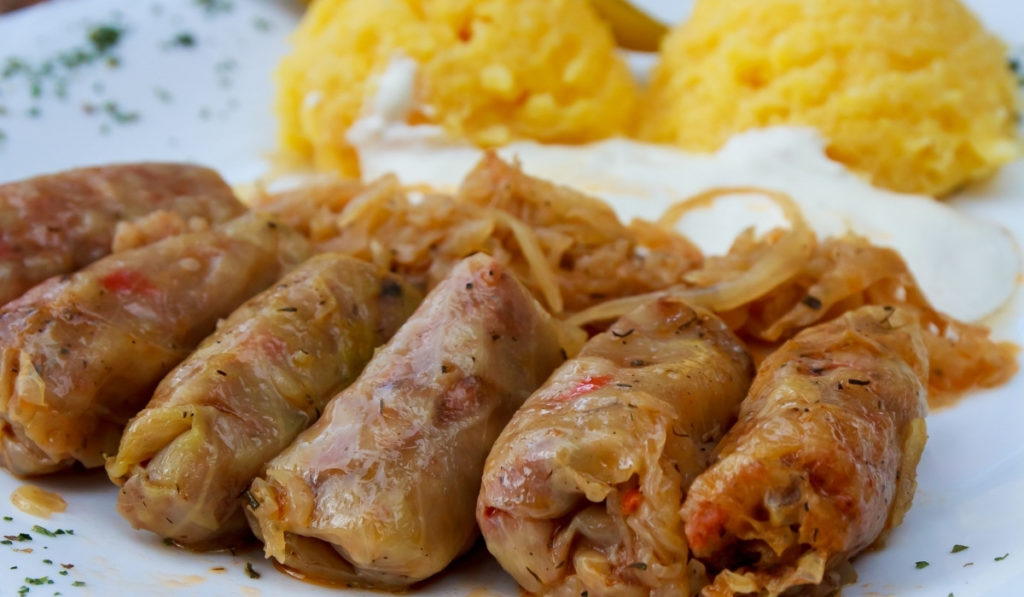
Nothing screams ‘Romanian Christmas’ louder than sarmale. These are cabbage rolls, meticulously crafted by wrapping sour cabbage leaves around a sumptuous filling of minced meat, rice, and spices. Slow-cooked in tomato-based sauce and traditionally served with mămăligă (polenta) and a dollop of sour cream, they are the heart and soul of the Christmas feast.
Cozonac
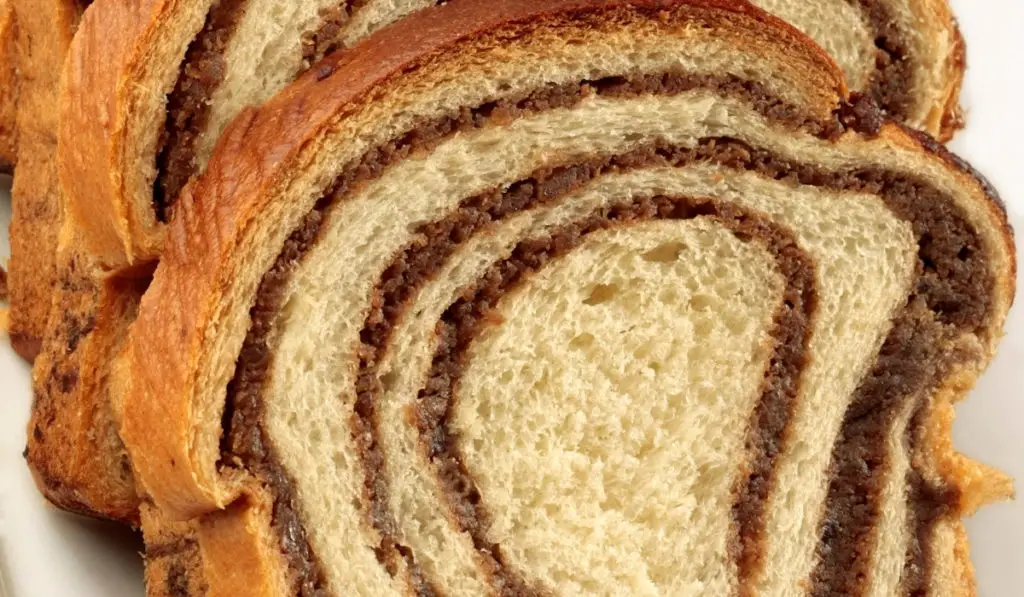
A Christmas meal is incomplete without a slice of cozonac. This fluffy sweet bread is generously filled with walnuts, cocoa, or poppy seeds, and sometimes raisins and Turkish delight. Each bite is a celebration in itself, providing comfort and sweetness amidst the winter chill.
Piftie
An acquired taste for some but a cherished dish for many, piftie is a cold jellied meat dish, usually made from pork trotters, garlic, and various spices. It showcases the culinary genius of utilizing the entire animal and crafting flavors over hours of slow cooking.
Toba and Caltabos
Direct outcomes of the tăierea porcului tradition, toba is a type of head cheese, while caltabos is a liver sausage. Both are savory delights adored by many (not me), adding depth and variety to the Christmas spread. You’re sure to find a good amount of slanina as well, a cured fat back.
Mămăligă
Mămăligă, similar to polenta, often plays second fiddle to the other dishes but is an essential companion. It balances out the rich flavors, providing a comforting base that complements the meats and sauces perfectly.
A Wide Array of Desserts
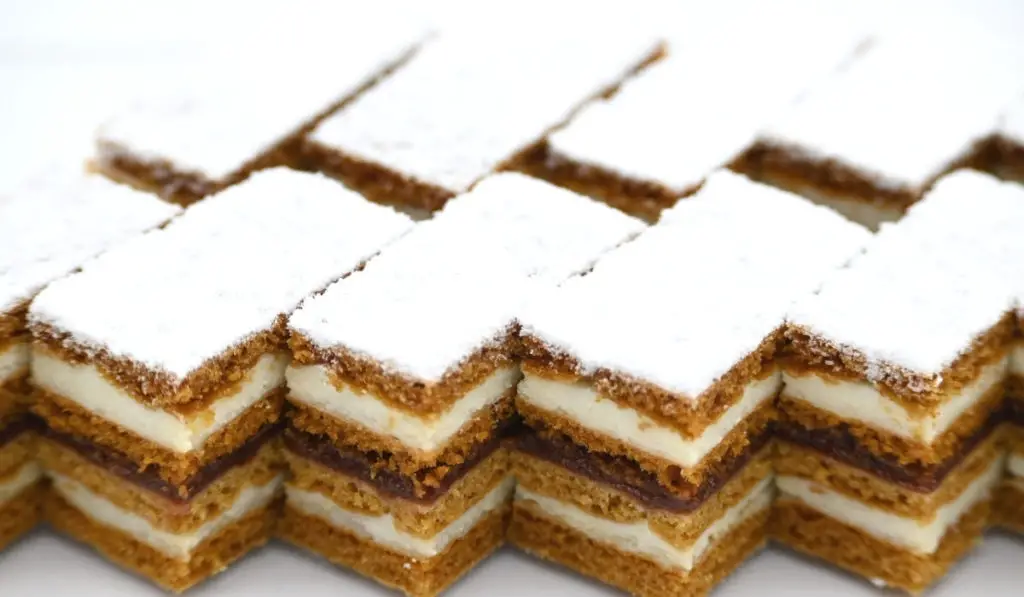
Beyond cozonac, tables are adorned with a variety of Romanian Christmas desserts. From nuci umplute (filled walnut cookies) to răcitură (a fruit-filled gelatin dessert) and all the layer cakes you can imagine, the sweet offerings ensure that the festive meal ends on a high note.
Diving into a Romanian Christmas feast is like embarking on a culinary journey, one that offers both familiar comforts and new delights. With every dish, you’re not just tasting ingredients; you’re savoring centuries of traditions, tales, and love.
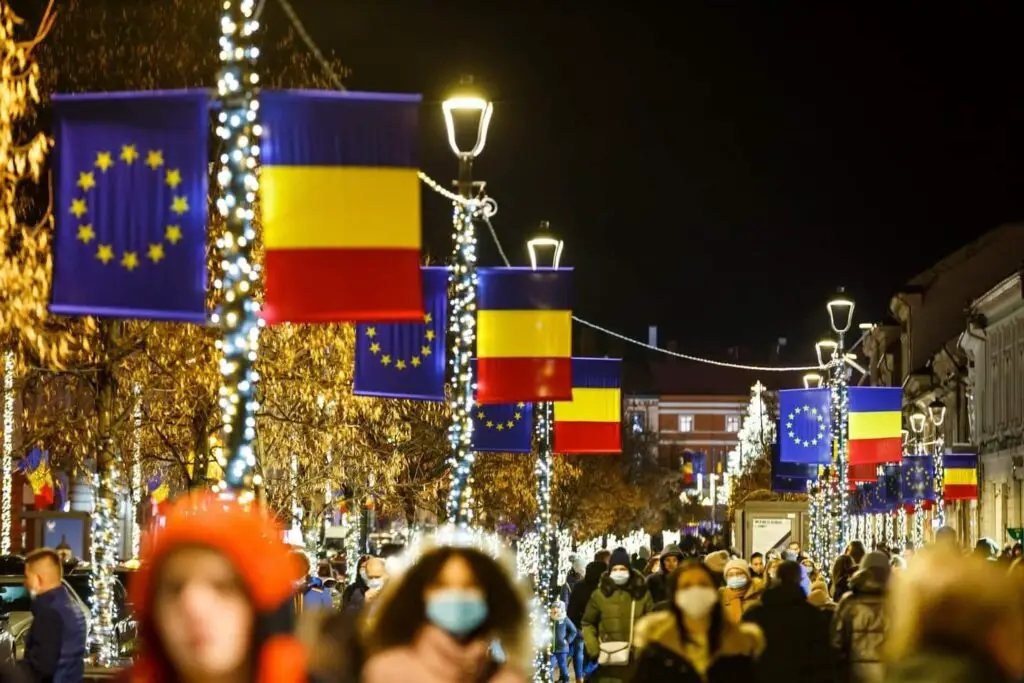
Unwrapping the Magic of a Romanian Christmas
And so, as the last crumbs of cozonac are savored and the final notes of colinde fade into the frosty night, we find ourselves immersed in the unique beauty of Romanian Christmas traditions. Through my years of living in this mesmerizing land, it’s become evident that Christmas in Romania is more than just a holiday; it’s a tapestry of rituals, traditions, and culinary wonders that intertwine to form an unforgettable experience.
From the snow-kissed streets of Sibiu to the bustling Christmas markets of Cluj-Napoca, every corner of Romania comes alive with festive spirit. And while the sights, sounds, and scents are undeniably captivating, it’s the warmth of the Romanian people, their passion for preserving traditions, and their love for sharing that truly defines this season.
If you want to swap Romanian for Merry Christmas, Crăciun Fericit! Here’s to cherishing old traditions, creating new memories, and finding joy in the simple, heartfelt moments that the festive season brings.

